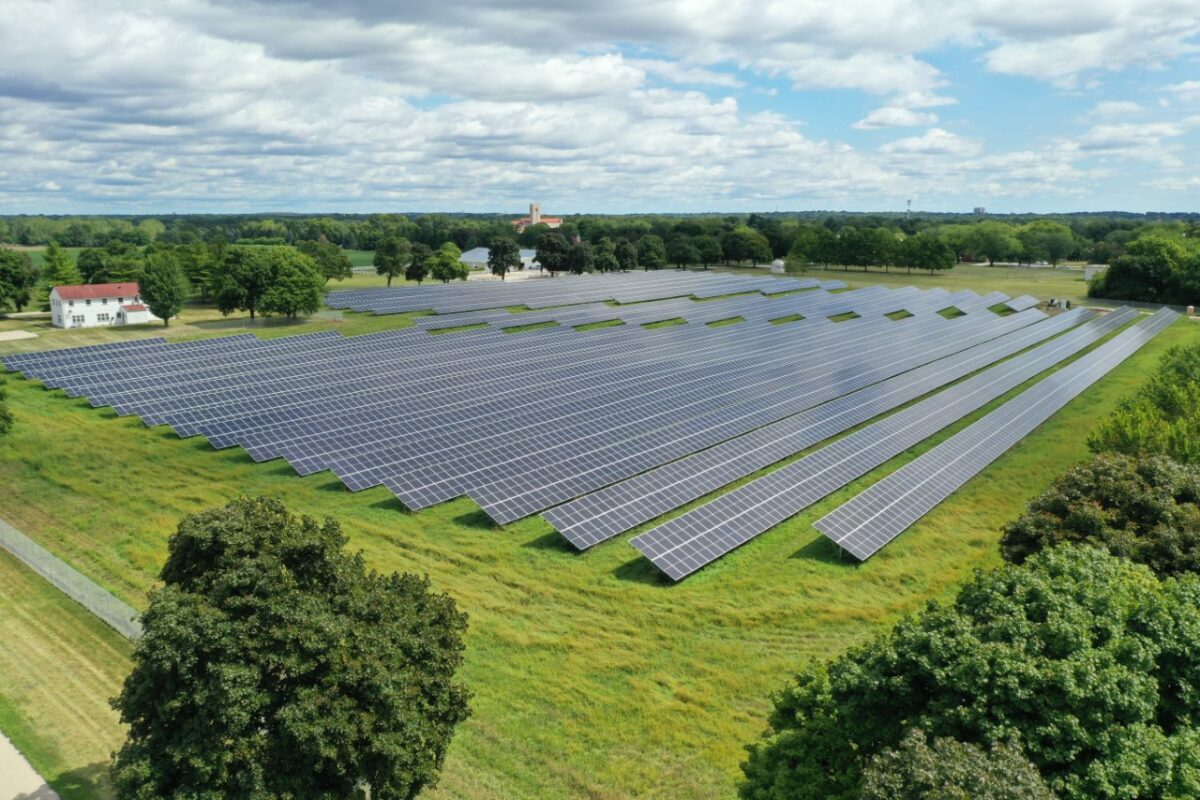As the world strives to combat climate change and embrace sustainable energy sources, community solar initiatives that allow multiple participants within a defined geography to share the benefits of the energy generated are a valuable way to both support and drive the clean energy transition.
Community solar projects – sometimes called “solar gardens” or “shared solar” – give communities, including residents and businesses, access to clean, affordable and reliable energy while also allowing them to reduce their carbon footprint. Yet the pace of these climate-friendly, forward-looking power sources has slowed due to challenges in attracting skilled Engineering, Procurement, and Construction (EPC) contractors needed to get these projects up and running.
The Power of Solar for Communities
Community solar projects help local communities take control of their energy supply. By decentralizing power generation, communities can reduce their dependence on fossil fuels and large-scale power plants and help decrease greenhouse gas emissions. Community solar has socioeconomic benefits too, allowing a broader range of individuals and businesses to benefit from renewable energy, regardless of income level. This is especially important for renters, low-income households in disadvantaged communities, and those with limited rooftop access to solar panels, because they can access clean energy and save on their electricity bills through various financial incentives and credits that are afforded to community solar projects. Businesses can benefit from lower utility costs as well.
Community solar projects also stimulate local economies, creating job opportunities and driving investment in the region.
What’s Hindering Widespread Solar Expansion?
Developers face several unique challenges when it comes to getting community solar projects off the ground, often due to the unique nature of these installations.
They are often smaller in scale than their utility-scale solar counterparts, so they can be less financially attractive to larger EPC contractors who want to optimize their resources for economies of scale and make their projects more profitable. The distributed nature of community solar, with numerous small installations spread across various locations, can also present logistical challenges that make the projects much more complex and ultimately reduce their profit margins.
Solving the Financing Puzzle
Financing the community solar projects can be challenging as well, with upfront capital and uncertain revenue streams limiting options for developers. This, in turn, can further discourage large EPC contractors who seek stable and predictable ventures.
The relatively small scale of community solar projects compared to larger, utility-scale installations can make it more difficult for developers to qualify for and secure lender funding. Uncertainty in revenue streams due to fluctuating energy prices, regulatory unpredictability, and even the variations in how much a community will embrace the move to solar add to the complexity. It’s clear that innovative financing models and supportive policies are needed to make community solar financially viable and attractive to investors.
Offering portfolios of projects to Engineering, Procurement, and Construction (EPC) contractors can serve as a creative solution to help community solar developers obtain financing and drive down the cost of building community solar projects. By bundling multiple projects together, developers can leverage economies of scale, streamline procurement processes, minimize project risk, and negotiate more favorable terms with EPC contractors. This approach allows contractors to optimize their resources and reduce overhead costs, resulting in lower overall project costs. Additionally, portfolios of projects provide contractors with a steady pipeline of work, reducing their reliance on larger utility-scale projects and incentivizing them to prioritize community solar developments. Ultimately, this collaborative approach benefits both developers and contractors, facilitating the expansion of community solar initiatives and accelerating the transition to renewable energy at the local level.
Regulatory Landscape Adds More Challenges
EPC contractors, especially those who are used to dealing with larger, standardized projects often find that navigating the unique regulatory landscape of different communities remains a cumbersome area of concern as well.
For example, local zoning and land-use regulations can vary from jurisdiction to jurisdiction, and unlike utility-scale solar installations that are generally found on large tracts of unoccupied land, community solar projects can be sited in a variety of areas including both residential and commercial.
As a result, community solar developers are forced to navigate a patchwork of local regulations, which can differ significantly from one community to another. Zoning laws, aesthetic considerations, and community engagement requirements can vary widely, adding yet another layer of complexity to the development process.
Larger solar projects, often located in remote or designated solar zones, might have a more standardized regulatory environment, making it somewhat easier for developers to navigate the approval process maze. The decentralized nature of community solar, while beneficial for inclusivity, creates a unique set of challenges in complying with diverse local regulations.
Limited awareness and understanding of community solar projects among EPC contractors may hinder their willingness to engage with these initiatives, and they simply may feel more familiar and comfortable with traditional utility-scale solar projects
In a way, the beauty of community solar projects also brings their biggest challenges. But working with a solar EPC firm that understands the nuances of this market – that these projects are inherently localized and require engaging with diverse communities, each with a unique set of considerations and challenges, can make a huge difference. Community solar EPCs must adeptly navigate the intricacies of smaller-scale installations, recognize the importance of community buy-in, and tailor their project designs to suit local landscapes. Simply put: the more a community solar EPC better comprehends the significance of community engagement, diverse financing models, and the necessity for flexibility in project execution, the better able they are to craft solutions that resonate with the specific needs and aspirations of the communities they serve.
Next Steps: Attracting EPC Contractors
Community solar developers should proactively seek partnerships with EPC contractors who have experience in smaller-scale solar installations or who are willing to diversify their portfolio. Collaborative efforts can combine expertise and resources to overcome challenges and deliver successful projects. Community developers should also target EPCs with shared values, and where there’s a true desire to establishing partnerships based on a collective commitment to community engagement, environmental sustainability, and innovative financing models. Hosting joint workshops, participating in industry events, and fostering open communication channels can facilitate a deeper understanding of each other’s objectives and capabilities.
Community solar developers – and EPC contractors – must actively work to build relationships founded on transparency and a mutual dedication to effective project development. They must align on the importance and unique aspects of community solar and get excited about working together to push forward solutions that bring economic growth and clean power, while reducing carbon emissions.
Financial incentives and attractive returns on investment can be highly effective in enticing skilled EPC contractors to participate, and innovative financing models, such as crowdfunding or public-private partnerships, can help to secure needed capital.
Community solar projects are critical links to help drive the energy transition toward a more sustainable future. Their ability to engage diverse communities, reduce emissions, and foster economic growth makes them invaluable components of the renewable energy landscape. While attracting skilled EPC contractors can pose challenges, concerted efforts by forward-thinking community EPC developers to streamline processes, offer financial support, and provide education and training can go a long way in enticing contractors to participate. By working together, stakeholders can accelerate the adoption of community solar and pave the way for a cleaner, greener, and more inclusive energy future.

William Tualau Fale is vice president, pre-construction & business development for Babcock & Wilcox Solar Energy, Inc., a commercial, industrial and utility solar EPC firm, and a subsidiary of Babcock & Wilcox Enterprises, Inc.
The views and opinions expressed in this article are the author’s own, and do not necessarily reflect those held by pv magazine.
This content is protected by copyright and may not be reused. If you want to cooperate with us and would like to reuse some of our content, please contact: editors@pv-magazine.com.








By submitting this form you agree to pv magazine using your data for the purposes of publishing your comment.
Your personal data will only be disclosed or otherwise transmitted to third parties for the purposes of spam filtering or if this is necessary for technical maintenance of the website. Any other transfer to third parties will not take place unless this is justified on the basis of applicable data protection regulations or if pv magazine is legally obliged to do so.
You may revoke this consent at any time with effect for the future, in which case your personal data will be deleted immediately. Otherwise, your data will be deleted if pv magazine has processed your request or the purpose of data storage is fulfilled.
Further information on data privacy can be found in our Data Protection Policy.